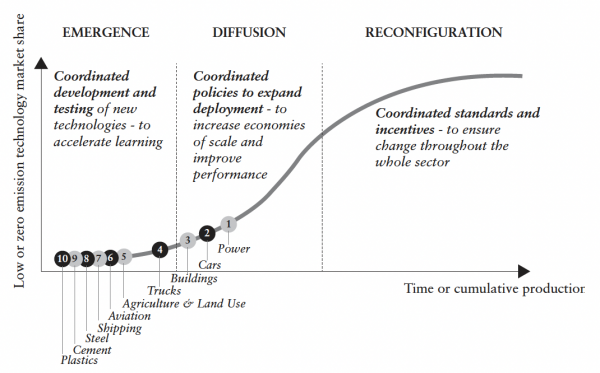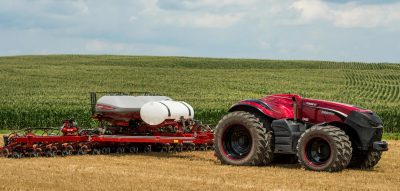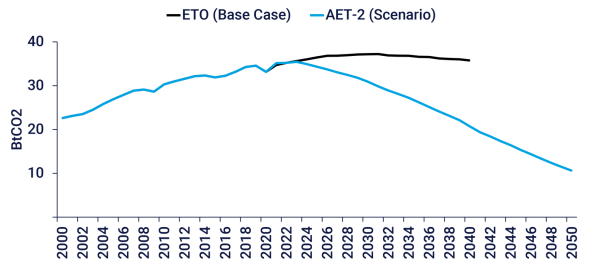
Is today’s energy transition unprecedented? Far from it. In fact, the 2020s are shaping up to be much like the 1920s, the “disruptive decade” of the last energy transition. If we’re looking for insights to help make sense of the 21st century transition, the emergence of power-farming during the early 20th century has a few lessons to offer.
A hundred years ago, horses provided most of the power on North American farms. Twenty-five years later, they had almost disappeared from fields and barns. That switch from horse-power to tractors and the internal combustion engine really began in the mid-1890s. It was an integral part of the 20th century transition from muscles and steam to oil.

Think of energy transitions as one set of energy technologies displacing another over a half-century or so. Now think of the process as an S-curve like Figure 1 that shows the speed at which technologies are adopted. Now add a bell curve with the different types of technology adopters and the approximate percentage of the population that they comprise. Unless you’re an economics professor, those two curves are all you need to grasp energy transition basics.
During the first two or three decades, new technologies are expensive, don’t work all that well, and the left side of the S-curve is fairly flat. They show enough promise, though, for Innovators and Early Adopters to buy them, which in turn encourages continual improvement.
The new technologies eventually become competitive around the third decade, reaching the inflection point on the curve where they begin pushing the existing technologies out of the market. The S-curve then bends upward more steeply. This is the disruptive decade, when adoption accelerates and change happens quickly. Change slows during the fourth decade as Late Majority and Laggard adopters gradually adopt the new energy technologies. By the end of the fifth decade the energy transition is pretty much complete.
Slow change for two or three decades, a decade of rapid change, followed by more decades of modest change as the new technology becomes dominant is a simple model that explains the 20th century energy transition as it played out in North American agriculture. It’s also a pretty good model for understanding the 21st century energy transition.
The 1920s was the disruptive decade, just like the 2020s

Giant steam tractors first lumbered onto farms in the late 19th century. These were costly and mostly used on large commercial farms, and then only to cultivate or “break” new land for the first time.
World War I changed everything.
Henry Ford introduced the small, cheap Fordson tractor in 1919 and smaller farmers jumped at the chance to replace horses with machines. The combined thresher or “combine” followed in the mid-1920s, lowering costs and making farmers less dependent on the availability of custom threshers, an important consideration when rain or snow during harvest could mean losing all or some of the crop.
The Great Depression of the 1930s slowed farm mechanization, but the technology kept improving. Innovations like the power-takeoff and rubber tires set the stage for faster adoption during World War II when labour shortages sped up mechanization. A few years after the war it was hard to find a horse in a field anywhere in North America.
The 2020s certainly appear to be the disruptive decade of the 21st century energy transition. Many of the key clean energy technologies – wind, solar, batteries, electric vehicles – are now competitive with fossil fuel technologies and beginning to take a large market share. And that share will be much bigger by 2030. Economist Werner Antweiler argues that the world is entering the Second Age of Electricity.

The power sector has hit the inflection point, as the International Energy Agency forecasts that 75 per cent of all new electricity generation during the 2020s will be renewables. Electric vehicles are close to inflection, with BloombergNEF forecasting that EVs will account for 28 per cent of global new car sales by 2030 (up from 2.7 per cent in 2020) and 58% by 2040. Technology to electrify commercial and residential buildings, like heat pumps, is rapidly maturing and right behind EVs on the S-curve.
Not all technologies diffuse at the same rate, though, as Figure 2 shows.
Sectors like aviation and cement production are difficult to decarbonize and progress will be slow until the 2030s. These industries will be disrupted a decade or more later than the others. But the electricity system, ground transportation, and buildings account for a significant proportion of primary energy demand.
Energy transitions change societies and economies in a big way
My 95-year old mother-in-law Doris grew up on a farm in northeast Saskatchewan, Canada near a little town called Alsysham during the 1920s and 1930s. She tells stories of her mother cooking huge meals for the dozen men who worked the steam tractor-powered threshing machines during harvest. Now, the family farm has grown to thousands of acres managed by her nephew and one part-time helper.

“What once took many men can now be done by one man,” she says.
The stratospheric rise in labour productivity wrought by mechanization is why the percentage of North American workers employed in agriculture has shrunk to two per cent from around 30 per cent in 1920.
The effect on rural areas was profound. Where once every quarter-section (160 acres) supported a family, now the countryside is almost empty. Little towns like Alysham are deserted. The grocery and hardware stories fondly remembered by Doris are long gone because the remaining farmers drive on modern roads in comfortable pickup trucks to shop in regional business hubs.
Canadians and Americans now live in towns and cities, which themselves were transformed by the transition from horses to automobiles that accelerated during the 1920s. The suburbs are essentially an invention of the car, for example.
The clean energy transition will bring about its own profound changes on work and living, says Tony Seba, who chronicles disruptive change as the co-founder of ReThinkX:
“The implications of this clean electricity disruption are profound. Not only can it solve some of society’s most critical challenges but it will usher in hundreds of new business models and create industries that collectively transform the global economy. When a system generates hyperabundant electricity at a marginal cost close to zero, the potential for new value creation is limitless.”
For example, hydrogen made with electrolyzers and cheap electricity will decarbonize industries like steel-making, marine shipping, and long-haul freight trucking that are difficult to electrify. Governments around the world, including Ottawa and a number of provinces, have hydrogen strategies. Low-cost wind and solar resources in Alberta and Saskatchewan could lead to a thriving hydrogen industry, perhaps combined with “blue hydrogen” in which natural gas is the feedstock and carbon dioxide is captured and stored underground.
In 2017, Seba predicted that autonomous electric “robo-taxis” would drive the cost of transportation so low (by a factor of four to 10 times lower than the current cost per kilometre of 23 cents for an EV in Canada) that by 2030 families would no longer own cars. Autonomous driving turned out to be a more difficult challenge than he anticipated, but already autonomous shuttles are being used at some US airports and have been tested in Canada. Transit expert Dr. Josipa Petrunic thinks they may be soon be used to make light rapid transit systems more convenient and efficient. And Sagie Evbenata of Guidehouse Insights thinks robo-taxis should start appearing in North American cities by the mid-2020s.
At the end of this decade, Canadians will look back on 2021 and be astonished by the changes to the power, transportation, buildings, and industrial sectors. Imagine how much more will have changed by 2050.
Innovation, capital, consumers drive energy transitions
The world was a simpler place a century ago, not least because there was less government policy and regulation affecting agriculture. In fact, for all intents there was no policy or regulation. Yet, farmers switched from horses and steam to tractors and the internal combustion engine at a healthy clip for a variety of reasons that had nothing to do with governments.
Some of them were purely economic. The cost to plough an acre with a horse was higher than with a tractor, just as the cost to thresh a bushel of wheat was lower with a combine. Prairie farmers quickly realized that they could farm two quarter-sections of land with a tractor, lowering their costs even further – while unwittingly setting the stage for rural depopulation.
Some of them were cultural. Farm kids returning from European battlefields where they had been introduced to mechanized warfare – planes, tanks, trucks, motorcycles – viewed power-farming as progressive and modern. Horses required daily care and attention, whereas the tractor quietly sat in the barn until it was needed. The young farmers of the 1920s viewed horses the same way today’s youth view telephone landlines: a relic of the past.
 Public support for power-farming was limited to education activities like the University of Saskatchewan’s “tractor schools.” Farmers would gather at a neighbour’s farm to watch professors E.A. Hardy or A.R. Greig demonstrate how to use, maintain, and repair mechanized equipment. These events were very popular. They’re credited with speeding up the adoption of power-farming and smoothing the transition away from horse-drawn technology.
Public support for power-farming was limited to education activities like the University of Saskatchewan’s “tractor schools.” Farmers would gather at a neighbour’s farm to watch professors E.A. Hardy or A.R. Greig demonstrate how to use, maintain, and repair mechanized equipment. These events were very popular. They’re credited with speeding up the adoption of power-farming and smoothing the transition away from horse-drawn technology.
A common view these days is that our energy transition is driven by climate policy. A more accurate take is that policy primed the pump by supporting clean energy and technology during the early stages of development. The pump, however, is now gushing water all on its own. Capital is flooding into the clean energy and technology sectors as companies (and countries) compete for early market dominance.
But global resolve to fight climate change means policy will speed up the energy transition as governments enact carbon pricing, industrial policies, and regulations. The question is, how robust will policy be? US President Joe Biden’s first 100 days in office suggest it will be more robust than expected even a year ago. Time will tell, though, whether the new Administration can deliver on its promises or if a new administration in 2024 slams on the brakes.
If current trends continue, a safe bet is that the transition accelerates even faster than expected during the 2020s. A recent Wood Mackenzie study estimates that if policies succeed in limiting global warming to 2 degrees Celsius by 2050, global oil consumption will drop from 100 million barrels per day to only 30 million, though methane gas demand remains strong for many decades as it displaces coal.

Buckle up, we’re in for a bumpy ride
Are the 20th and 21st century energy transitions identical? Not even close.
The biggest difference is probably the timeline. The scale and complexity of the current transition ensures that those regions leading the change – North America, Europe, and parts of Asia like China, Japan, and South Korea – could require decades after 2050 for fossil fuel use to fall below 20 per cent. Latin America, Africa, and the remaining Asian countries may not be done until the end of the century or after.
Still, there are plenty of similarities: the disruptive third decade, the profound changes to economies and societies that appear to be on the horizon, and the importance of innovation, capital, and markets as the primary drivers of the transition (though policy will play an important role influencing the pace of change).
Watching these trends play out over the next decade will be fascinating now that we know what to look for.


Be the first to comment